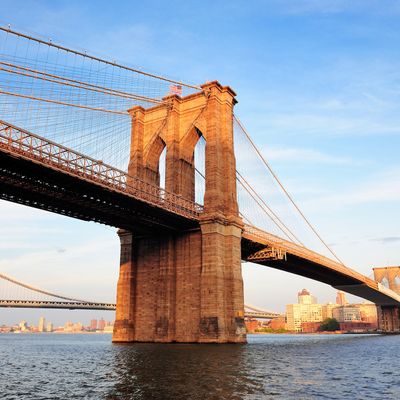
This year’s major fall restaurant preview pieces are all in, and if you’ve spent any amount of time looking through them, you’ve probably noticed there’s a serious dearth of upcoming Brooklyn restaurants. In turn, it might be time to ask: Has Kings County’s upstart restaurant scene officially reached its peak?
There are restaurants opening in Brooklyn, but many of them don’t feel like events. Two of the biggest names listed — Four & Twenty Blackbirds and Ganso Yaki — are spinoffs, while another opening is inside the Botanic Gardens. Then, there are mini-chains: Michael Psilakis’s MP Taverna will open its fourth location overall, in Williamsburg, combined with a beer hall. There’s nary a Blanca or Dover in sight.
Meanwhile, ambitious high-end venues, like Enrique Olvera’s Cosme, and anticipated high-low mash-ups like Sarah Simmons’s Champagne- and fried-chicken-based Birds & Bubbles or Alex Stupak’s Empellón al Pastor, are opening in Flatiron, the East Village, and the Lower East Side. Even the new Brooklyn Fare Chef’s Table is opening in … Hell’s Kitchen. Manhattan has always been the city’s power center for restaurants, of course, but the dynamic feels far more out of balance than it has in recent years.
So what’s going on? A look at the evidence reveals a number of factors that could be contributing to the borough’s decreased appeal among restaurateurs.
Brooklyn’s rents aren’t as enviable as they once were. Manhattan’s restaurant economy continues to weather an era of insane rents combined with intermittent bouts of course correction, but the truth is there are still great deals in Manhattan. The median rent for a Williamsburg one-bedroom has now surpassed the same in the Upper East Side and the East Village, and the equalization will continue. Manhattan is still central, dense with potential customers. For many owners, most of Brooklyn continues to seem decentralized and speculative. “The only place restaurants can go anymore is the perimeter of Manhattan,” a broker told us in July, but the same can’t be said for much of Brooklyn, and Manhattan’s fringes are still relatively more appealing than neighborhoods like Crown Heights and Bed-Stuy, where chef-centered, destination places have an almost nonexistent track record.
Bars are better bets. It’s no coincidence that 10 of the 20 forthcoming nightlife spots in New York’s roundup are in Brooklyn — ambitious bars have supplanted innovative restaurants, or at least come first, especially in gentrifying areas, where the odds of making it as a neighborhood bar are far greater than the chances you’ll succeed with a twenty-course tasting menu counter and needle-nose tweezer food.
Williamsburg has become a repository for chains. Bedford Avenue’s freak flag is long gone and the area is now safe for multi-unit players: Starbucks has infiltrated Williamsburg and is working on a second location. Meanwhile, chainlets like Parm, Umami Burger, and Sweetgreen are gobbling up pre-portioned retail spaces in new mixed-use conversions. They may be great places to eat, but the days when it wasn’t unusual to stumble upon an unknown vegan prix fixe place decorated with severed doll’s heads are all but extinct. In other words: The frontier has diminished, and there’s no longer the same competitive cultural cachet to be had by opening in Brooklyn instead of Manhattan.
Some of the biggest openings are happening in boutique hotels — and most of the high-powered ones happen to be in Manhattan. Josh Pickard, Luke Ostrom, and Andrew Carmellini will open Little Park at the redesigned Smyth this fall, while team Torrisi’s Dirty French officially opens today in the Ludlow Hotel. Even Danny Meyer’s next big restaurant, Marta, is in a hotel. In-demand chefs and owners are naturally going to be the first choice of hotels that view name-brand restaurants as must-have amenities. Since the business deals tend to be far more preferable for restaurant owners than stand-alone spots, it’s a no-brainer that lots of big names now gravitate toward hotels. In fact, the era of the above-par chef-centric hotel restaurant appears poised to begin anew, in full, this year.
Manhattan is still … Manhattan. This fall, in addition to Olvera flying in from Mexico City to make “single-origin” tortillas, Korean chain Baekjeong is setting up its U.S. flagship in K-Town, and an ambitious British chain is coming with hamburgers and lobster, presumably with more on the way. Some of the most heavily praised chefs in the country will also be hanging out for few weeks at a clip in a deluxe kitchen inside the Puck Building, perhaps because even if they’re not opening there, out-of-town chefs are always going to gravitate toward Manhattan.
Related: 36 Restaurants Opening This Fall




